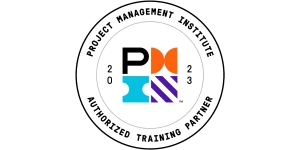Change Acceleration Process (CAP): Accelerating Lean Six Sigma Transformations
Today organizations face a common challenge: Implementing process improvements that actually stick.
Technical solutions alone rarely succeed without proper change management.
This is where the Change Acceleration Process (CAP) becomes invaluable, especially when paired with methodologies like Lean Six Sigma.
Ready to turn process improvements into lasting transformations?
Explore our Lean Introduction Classroom Training and gain the skills to lead change effectively.
The Change Acceleration Process offers a structured framework that helps organizations navigate the human side of change while implementing technical improvements.
Originally developed at General Electric, CAP has evolved into a powerful methodology that complements Lean Six Sigma initiatives by addressing the critical people factors that often derail improvement efforts.
Many professionals find that combining CAP with Six Sigma certification creates a powerful skillset for driving organizational change.
Key Highlights
- Essential CAP model components
- Practical tools for implementation
- Integration with Six Sigma projects
- Real-world success strategies
What Is Change Acceleration Process (CAP)?
The Change Acceleration Process (CAP) emerged in the late 1980s at General Electric under the leadership of CEO Jack Welch.
Facing intense global competition, GE needed to transform quickly but found that technical solutions alone weren’t driving the necessary changes.
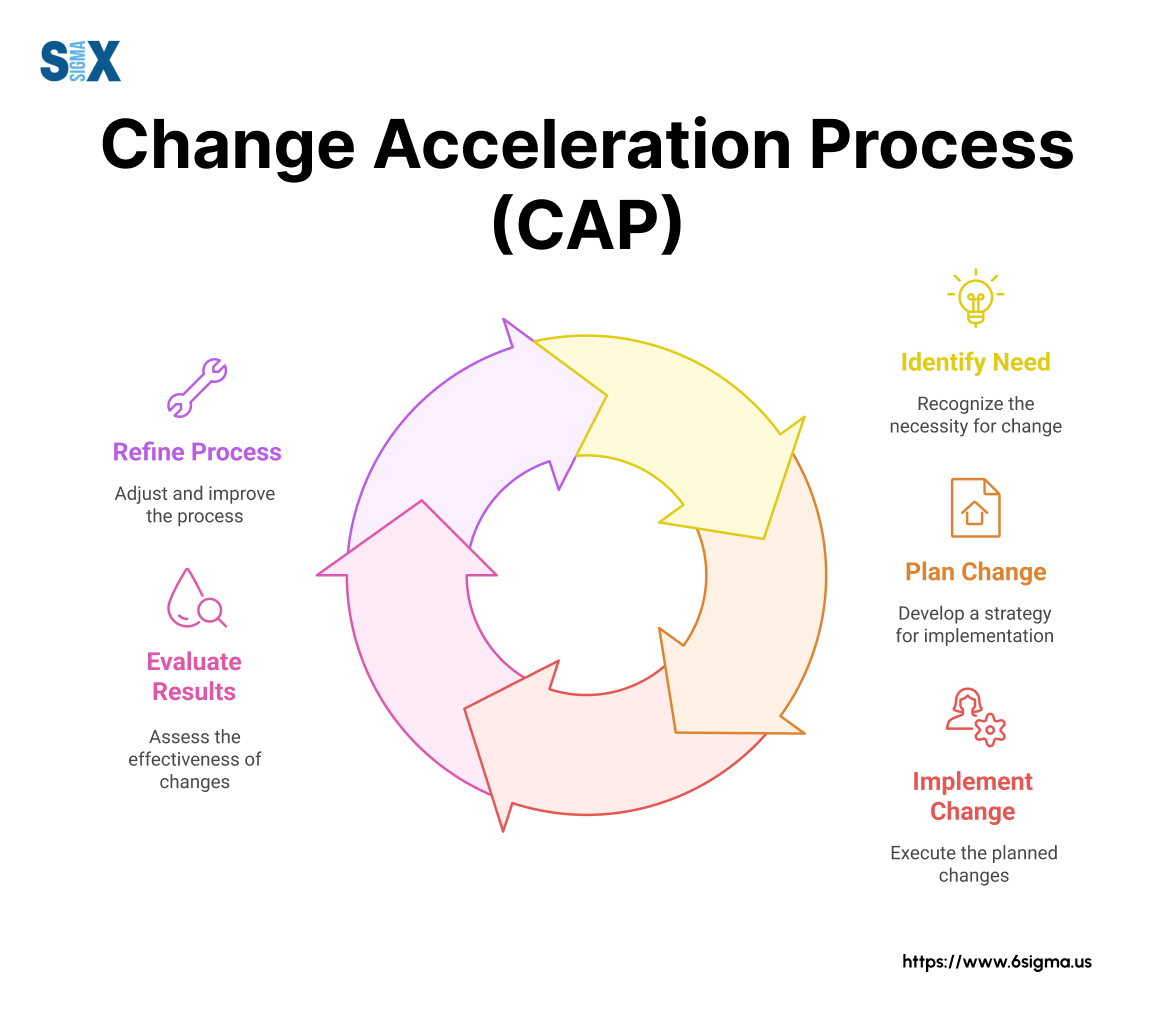
Welch recognized that successful transformation required addressing the human side of change.
GE’s internal research revealed a crucial insight that would become the foundation of the change acceleration process: organizational change succeeds or fails based on both the quality of the solution and people’s acceptance of it.
This led to the development of the CAP equation:
Q × A = E
Where Q represents the quality of the technical solution, A represents acceptance of the change, and E represents the effectiveness of the implementation.
This simple yet powerful formula demonstrates that even the most brilliant technical solution (high Q) will fail if acceptance (A) is low or non-existent.
Traditional change management approaches often prioritize the technical aspects while treating employee buy-in as an afterthought.
The change acceleration process flips this model by placing equal emphasis on both elements from the start.
Unlike conventional methods that focus primarily on project plans and deliverables, CAP addresses the emotional and psychological aspects of change that frequently cause resistance.
What makes the change acceleration process particularly valuable is its practical framework. Rather than vague concepts, CAP provides specific tools and techniques that organizations can immediately apply to their change initiatives.
This structured approach helps teams navigate the complex human dynamics that often derail transformation efforts.
Many organizations implement CAP alongside other improvement methodologies. For example, when paired with lean introduction principles, the change acceleration process helps ensure that process improvements gain traction and deliver lasting results.
This combination addresses both the technical and human elements required for successful organizational transformation.
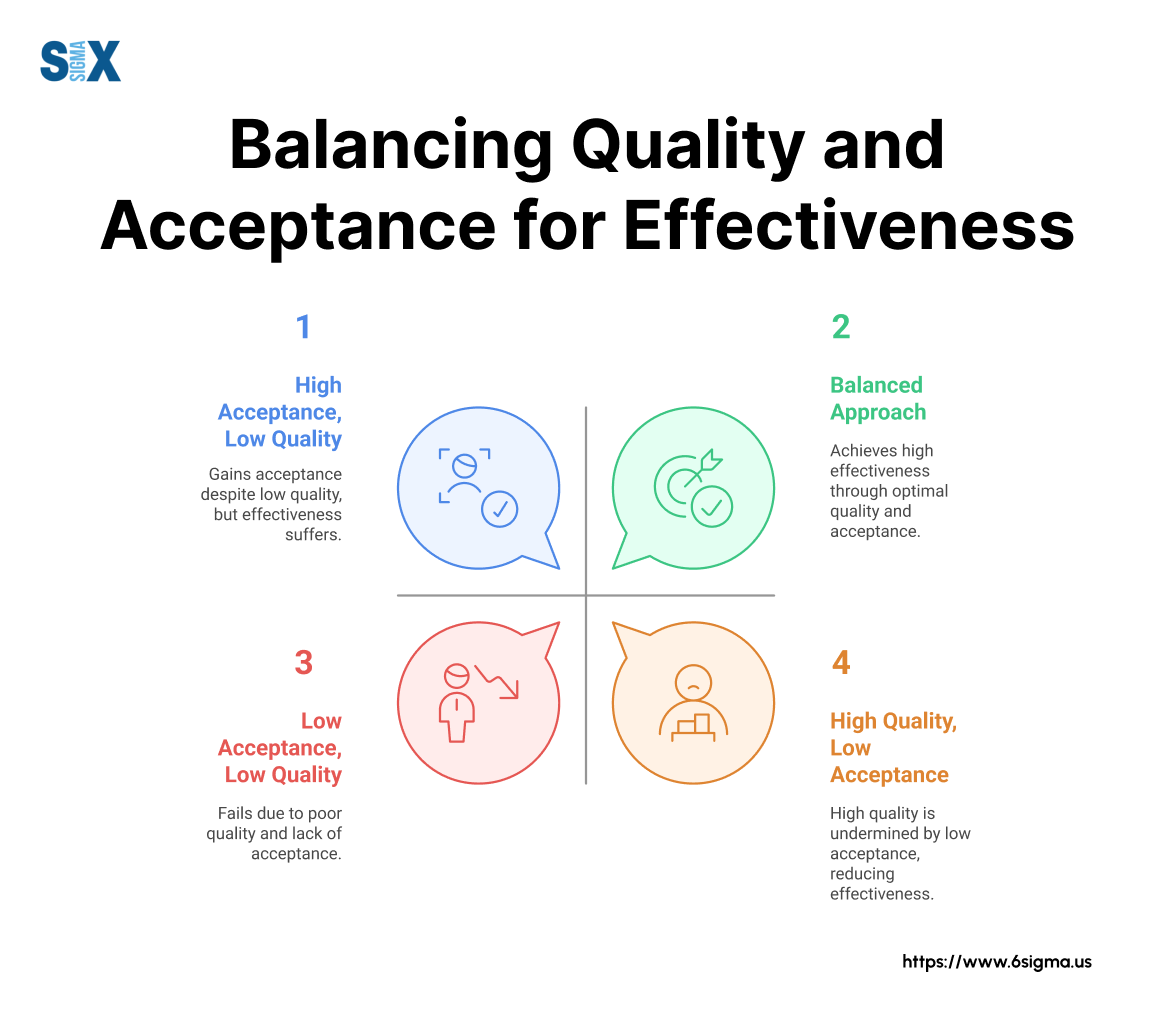
The Seven Elements of CAP in Lean Six Sigma
The change acceleration process model consists of seven interconnected elements that provide a roadmap for managing the human aspects of change.
When applied to Lean Six Sigma initiatives, these elements help organizations overcome resistance and accelerate adoption of process improvements.
Leading Change
Effective leadership forms the foundation of any successful transformation. In Lean Six Sigma projects, leaders must demonstrate visible commitment to the change acceleration process by actively participating in improvement activities.
This means not just verbally supporting the initiative but modeling the desired behaviors. Leaders who apply CAP principles allocate appropriate resources, remove obstacles, and hold themselves accountable for both technical excellence and team engagement.
Creating a Shared Need with the Change Acceleration Process
Before jumping into solutions, the change acceleration process emphasizes establishing a compelling reason for change.
In Six Sigma terms, this aligns with the Define phase, where teams identify critical customer requirements and process pain points. Data-driven analysis helps create urgency by quantifying the gap between current performance and desired outcomes.
When team members understand why change is necessary, resistance diminishes and motivation increases.
Shaping a Vision
The cap model requires a clear vision that helps stakeholders visualize the future state.
For Lean Six Sigma practitioners, this means articulating how process improvements will benefit customers, employees, and the organization.
Effective visions in the change acceleration process are specific, measurable, and emotionally resonant. They answer the question: “What will success look like when we implement these changes?”
Mobilizing Commitment with the Change Acceleration Process
This element focuses on building a critical mass of support. Using stakeholder analysis tools from the change acceleration process, Six Sigma teams identify key influencers whose support is essential.
Change agents then develop targeted strategies to address concerns and secure buy-in. This element recognizes that different stakeholders require different approaches based on their interests and influence.
Making Change Last
Sustainability is crucial in both the change acceleration process and Lean Six Sigma. This element involves embedding new behaviors through reinforcement mechanisms, recognition systems, and performance metrics.
Organizations applying the CAP model within Six Sigma initiatives establish control plans that monitor both technical performance and adoption rates.
Monitoring Progress
The change acceleration process emphasizes tracking both technical results and people-related metrics.
For Six Sigma certification holders, this means expanding traditional project dashboards to include measures of stakeholder engagement, communication effectiveness, and resistance levels.
Changing Systems and Structures with the Change Acceleration Process
The final element addresses organizational enablers and barriers. Six Sigma teams applying the change acceleration process evaluate whether existing policies, procedures, and reward systems support or hinder the desired changes.
This systemic view ensures that the environment reinforces new behaviors rather than pulling people back to old patterns.
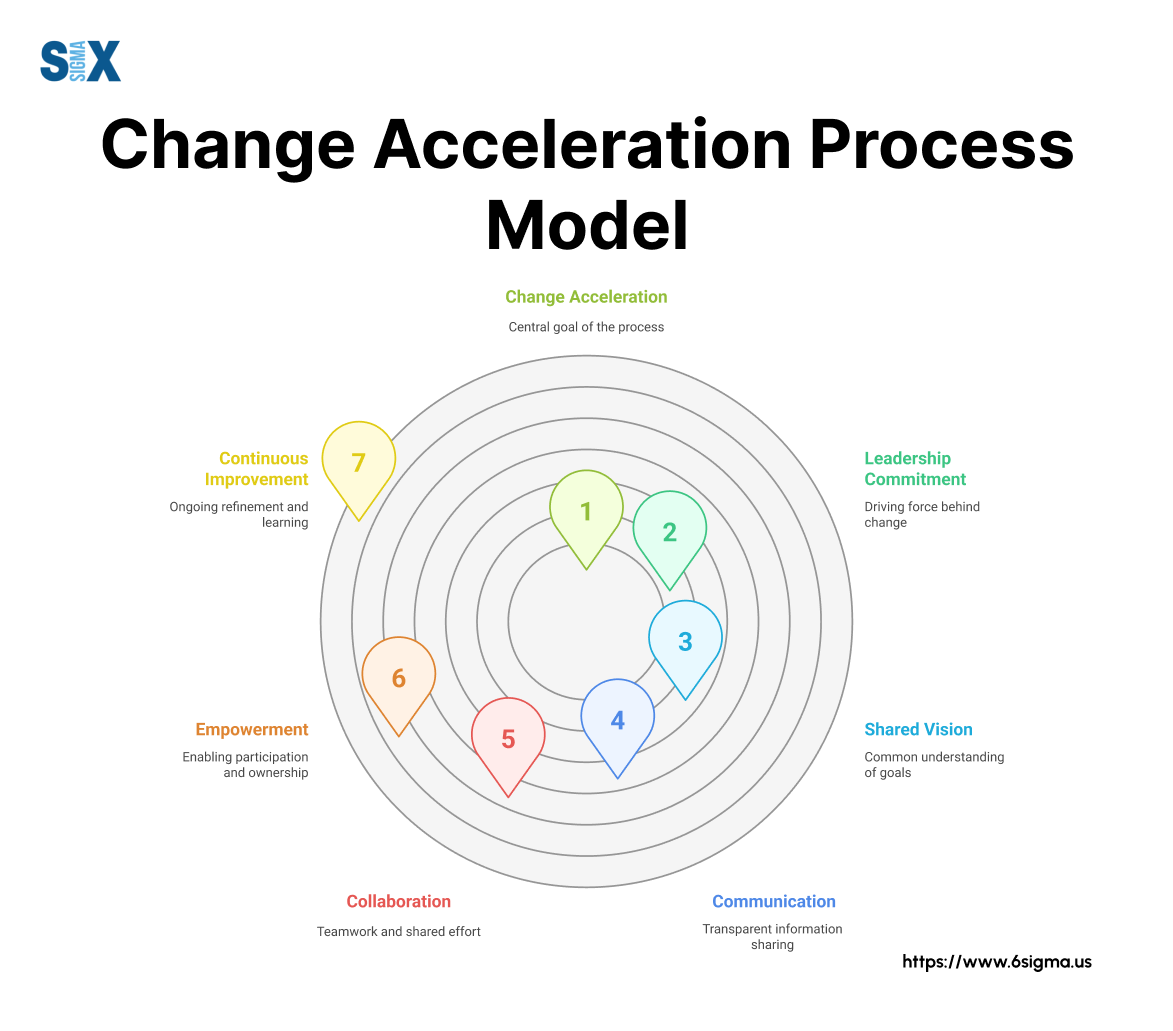
Is Your Organization Ready for CAP?
Take Our 2-Minute Readiness Assessment.
Before implementing the Change Acceleration Process, it’s crucial to understand where your organization stands in terms of change readiness.
Note: This assessment provides a high-level indication of readiness. Detailed organizational assessment may be needed for comprehensive implementation planning.
Essential Change Acceleration Process (CAP) Tools for Six Sigma Practitioners
The change acceleration process equips practitioners with practical tools that complement technical Six Sigma methodologies.
These tools help teams address the human aspects of change that often determine whether process improvements succeed or fail.
Stakeholder Analysis Matrix
Successful implementation of any change requires understanding who will be affected and how they might react. The stakeholder analysis matrix is one of the most valuable cap tools six sigma practitioners can use.
This structured approach helps identify key individuals and groups impacted by a change, assess their current level of support, and determine strategies to increase their commitment.
The matrix typically plots stakeholders on two axes: influence/power and interest/impact. This visualization allows change agents to prioritize their engagement efforts.
For high-influence stakeholders who oppose the change, teams develop targeted strategies to address concerns and build support. For those already supportive, the focus shifts to leveraging their influence to champion the initiative.
What makes this tool particularly effective is its ability to uncover hidden resistance early in the process. By mapping stakeholders before implementing technical solutions, teams can proactively address potential roadblocks rather than reacting to resistance after it emerges.
Change Readiness Assessment
Before implementing process improvements, Six Sigma teams need to gauge organizational readiness for change.
The change readiness assessment tool measures factors like:
- Previous change experience and success rate
- Leadership alignment and commitment
- Employee motivation and capacity for change
- Organizational flexibility and adaptability
- Available resources and support systems
This change acceleration process tool produces a readiness score that helps teams determine whether to proceed with implementation or first address readiness gaps.
For example, if the assessment reveals low leadership commitment, teams might delay technical implementation while focusing on executive engagement activities.
Communication Planning Tools
Effective communication stands as perhaps the most critical element of successful change initiatives.
The change acceleration process includes specialized communication planning tools that help Six Sigma teams craft messages that resonate with different stakeholder groups.
These cap tools six sigma practitioners use include message mapping templates, communication calendars, and feedback collection mechanisms.
The key principle behind these tools is tailoring communication to address the specific concerns of each audience segment.
Technical teams often focus on data and methodology, but effective change communication must also address emotional responses to change.
Lean Six Sigma Green Belt certification incorporate these change acceleration process tools alongside traditional statistical methods, recognizing that technical excellence alone doesn’t guarantee successful implementation.
Want to become a change management expert?
Our Lean Six Sigma Overview course provides comprehensive insights into implementing successful change initiatives.
Integrating Change Acceleration Process (CAP) with DMAIC
Six Sigma practitioners often struggle with implementing technically sound solutions because they overlook the human factors that drive acceptance.
By integrating the change acceleration process with the DMAIC methodology, organizations can address both technical excellence and stakeholder buy-in simultaneously.
This integration creates a powerful approach to cap process improvement that delivers sustainable results.
Mapping CAP Elements to DMAIC Phases
The DMAIC framework (Define, Measure, Analyze, Improve, Control) provides a structured approach to process improvement.
Each phase of DMAIC can be enhanced by incorporating specific change acceleration process elements:
During the Define phase, teams should focus on “Creating a Shared Need” from the CAP methodology. This means not just defining the problem technically but framing it in ways that resonate with stakeholders.
Successful cap six sigma practitioners establish a compelling case for change by connecting process deficiencies to business impacts that matter to different audiences.
In the Measure and Analyze phases, while collecting data and identifying root causes, teams should implement the “Mobilizing Commitment” element.
This involves engaging stakeholders in data collection and analysis activities, which builds ownership and validates findings. The change acceleration process emphasizes transparent sharing of data to build credibility and trust.
The Improve phase aligns naturally with “Shaping a Vision” and “Making Change Last” from the CAP framework.
As teams design solutions, they should visualize and communicate the future state in compelling ways. Cap process improvement efforts succeed when stakeholders can clearly see how the changes will benefit them.
Finally, the Control phase incorporates “Monitoring Progress” and “Changing Systems and Structures” to ensure sustainability.
This means establishing metrics for both technical performance and adoption rates, then adjusting organizational systems to reinforce new behaviors.
Synergies Between Change Acceleration Process (CAP) and Six Sigma Tools
The change acceleration process and Six Sigma methodologies complement each other through their respective tools.
For example, while conducting root cause analysis, teams can simultaneously apply stakeholder analysis to identify how different groups perceive the problem.
This dual approach ensures that technical solutions address both the process issues and stakeholder concerns.
Similarly, cap six sigma integration enhances communication planning.
The data visualization tools from Six Sigma (control charts, Pareto diagrams) can be leveraged in CAP communication strategies to make complex information accessible and compelling for various audiences.
The most successful organizations don’t treat cap process improvement as separate from technical improvement.
Instead, they weave change management activities throughout their DMAIC projects, creating a seamless approach that addresses both the technical and human aspects of change.
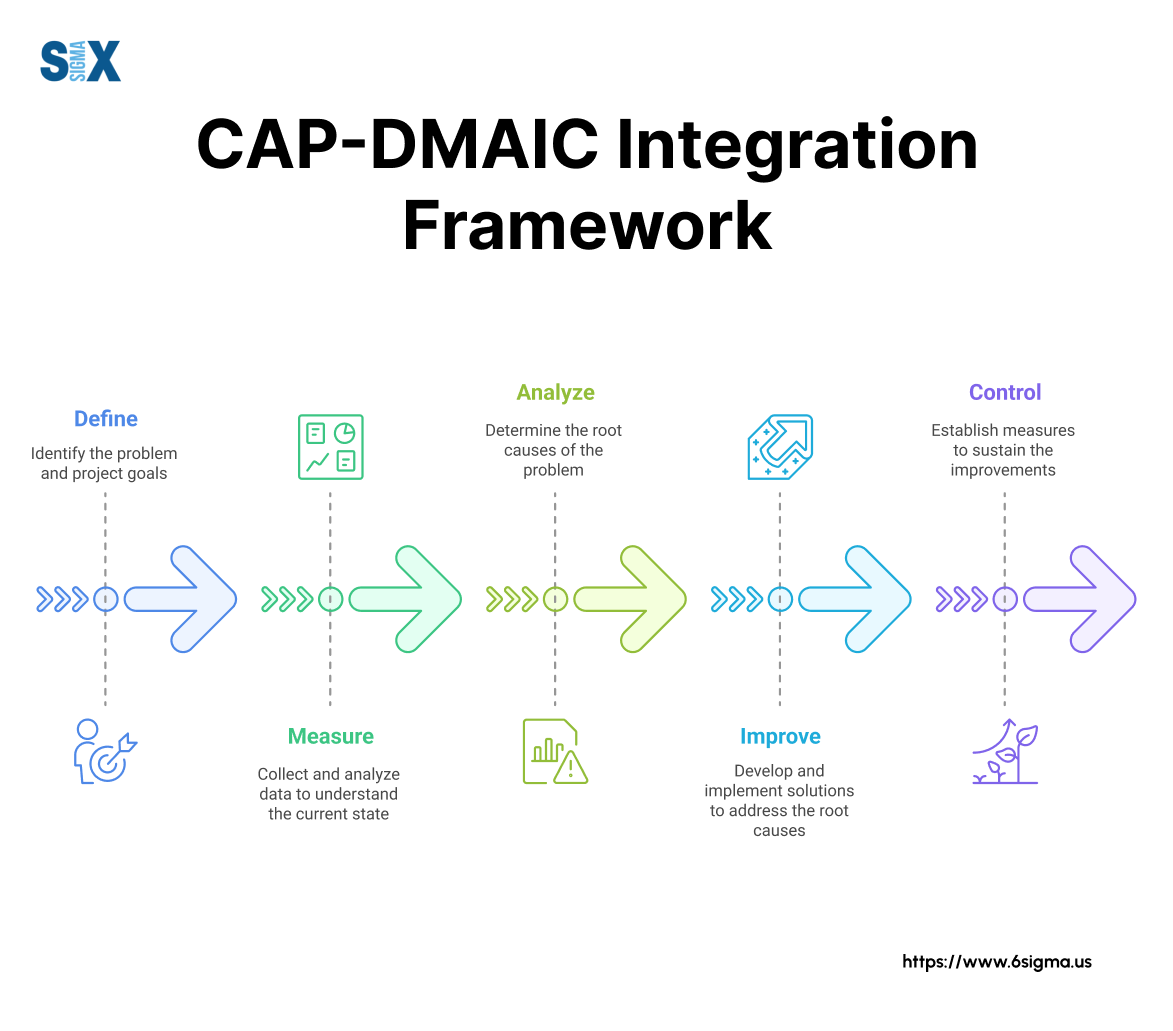
CAP Success in Six Sigma Projects
Organizations across various industries have demonstrated that implementing the change acceleration process alongside Six Sigma methodologies significantly improves project outcomes.
These real-world examples illustrate how the cap process addresses the human factors that often derail technical improvements.
Manufacturing Sector Transformation
A global automotive components manufacturer struggled with implementing lean manufacturing principles despite solid technical planning. Initial efforts focused exclusively on process redesign, resulting in employee resistance and limited adoption.
After introducing the change acceleration process, the company took a different approach to their production line optimization project.
The team began by creating a shared need through factory tours that highlighted inefficiencies and competitive threats.
They engaged production workers in mapping the current state and designing the future state, which built ownership.
The cap process emphasized two-way communication, with leaders spending time on the shop floor addressing concerns directly.
Healthcare Implementation Success
A regional hospital network applied the change acceleration process to their Six Sigma initiative aimed at reducing emergency department wait times.
Previous improvement attempts had failed despite technically sound solutions because they didn’t adequately address physician and nurse concerns about patient care quality.
Using cap process tools, the project team conducted stakeholder analysis that identified key influencers among the medical staff.
They created a communication plan that emphasized how process improvements would enhance patient care rather than just efficiency.
The team also established a cross-functional steering committee that gave clinical staff meaningful input into the redesign.
Service Industry Application of Change Acceleration Process (CAP)
A financial services firm applied the change acceleration process to their customer onboarding redesign.
The Six Sigma project aimed to reduce application processing time and error rates. Initial resistance came from relationship managers who feared streamlined processes would diminish their role.
The project team used the change acceleration process to reshape their approach.
They created a compelling vision that positioned relationship managers as trusted advisors rather than paperwork processors.
The team also established pilot groups that allowed employees to experience the new process and provide feedback before full implementation.
Implementation Guide
Implementing the change acceleration process requires thoughtful planning and execution.
Organizations that successfully deploy CAP follow a structured approach that integrates change management with technical improvements.
Step-by-Step Implementation Framework
Start with assessment and preparation before launching a cap change acceleration process initiative. First, evaluate your organization’s change readiness using structured assessment tools.
Identify potential barriers and enablers that might impact implementation. Then assemble a cross-functional team that includes both technical experts and individuals with strong interpersonal skills.
Next, align the change acceleration process with your existing project methodology. Map specific CAP activities to your project timeline, ensuring that change management tasks receive appropriate resources and attention.
Develop metrics that track both technical progress and stakeholder acceptance throughout the project lifecycle.
Training comes next in the implementation sequence. Provide team members with education on cap change acceleration process principles and tools.
This training should be role-specific, with project sponsors focusing on leadership aspects while team members learn practical application techniques.
The execution phase involves deploying the seven elements of the change acceleration process in coordination with technical work.
Begin with creating a shared need and shaping a vision before moving to detailed solution design. As implementation progresses, shift focus to making change last and monitoring progress.
Finally, establish a feedback loop to continuously improve your approach. Gather lessons learned after each project phase and adjust your change acceleration process methodology accordingly.
Best Practices and Tips for Change Acceleration Process (CAP)
Successful organizations integrate the change acceleration process into their existing governance structures rather than treating it as a separate initiative.
Project status reports should include sections on stakeholder engagement and resistance management alongside technical updates.
Communication represents a critical success factor in the change acceleration process.
Key Success Factors
Several factors distinguish successful change acceleration process implementations:
Leadership commitment stands as the most crucial factor. When leaders model the behaviors they expect from others and visibly participate in change activities, adoption rates increase dramatically.
Adequate resources also determine success or failure. Organizations must allocate sufficient time, budget, and personnel to change management activities, not just technical work.
Timing plays a vital role in effective implementation. The change acceleration process should begin before technical solutions are finalized, not after resistance emerges.
Develop advanced strategies for managing organizational change!
Take your change management skills to the next level with our Six Sigma Champion – Leadership Program, designed to equip you with cutting-edge tools and techniques.
Conclusion
The change acceleration process provides a structured approach to managing the human side of change that often determines whether technical improvements succeed or fail.
By integrating CAP with methodologies like Six Sigma, organizations can address both the quality of solutions and their acceptance by stakeholders.
As demonstrated through various industry examples, organizations that effectively implement the change acceleration process achieve faster adoption, more sustainable results, and higher stakeholder satisfaction.
The key lies in treating change management as equally important to technical excellence, not as an afterthought.
To get started with CAP in your organization, begin by assessing your current change management practices against the seven elements framework.
Identify gaps and opportunities for improvement, then develop an implementation plan that integrates change acceleration process principles into your existing project methodology.
SixSigma.us offers both Live Virtual classes as well as Online Self-Paced training. Most option includes access to the same great Master Black Belt instructors that teach our World Class in-person sessions. Sign-up today!
Virtual Classroom Training Programs Self-Paced Online Training Programs

